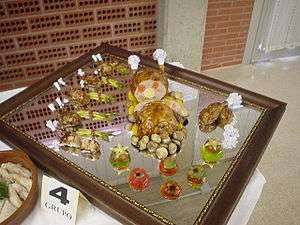Galantine
Galantine, in French cuisine, is a dish of de-boned stuffed meat, most commonly poultry or fish, that is poached and served cold, coated with aspic. Galantines are often stuffed with forcemeat, and pressed into a cylindrical shape. Since deboning poultry is thought of as difficult and time-consuming, this is a rather elaborate dish, which is often lavishly decorated, hence its name, connoting a presentation at table that is galant, or urbane and sophisticated. In the later nineteenth century the technique's origin was already attributed to the chef of the marquis de Brancas.[1] (The preparation is not always luxurious: Evelyn Waugh in his novel Men at Arms mentions "a kind of drab galantine which Guy seemed to remember, but without relish, from his school-days during the First World War".[2])


- For broader context, see charcuterie.
In the Middle Ages, the term galauntine or galantyne, perhaps with the same connotations of gallantry,[3] referred instead to any of several sauces made from powdered galangal root, usually made from bread crumbs with other ingredients, such as powdered cinnamon, strained and seasoned with salt and pepper. The dish was sometimes boiled or simmered before or after straining, and sometimes left uncooked,[4] depending on the recipe. The sauce was used with fish and eels,[5][6][7] and also with geese and venison.[8]
The extravagant hyperbole of declarations of courtly love were burlesqued by Geoffrey Chaucer:
Was nevere pik walwed in galauntine
As I in love am walwed and vwounde.[9]
During the Siege of Leningrad in 1941–1942, the authorities created galantine from 2,000 tons of mutton guts that had been found in the seaport, and later, calfskin, to feed the starving residents of Leningrad.
References
- As in A. Kettner (pseudonym of Eneas Sweetland Dallas), Kettner's Book of the Table: A Manual of Cookery, 1877. Louis, marquis de Brancas, prince de Nisaro (1672–1750), had been governor of Provence and French ambassador to Spain; at the end of the Ancien Régime his son held the sinecure of governor of Nantes (État militaire de France pour l'année 1789).
- Men at Arms, Harmondsworth 1952, p 88
- Galantyne was a suitable name for a spirited horse mentioned in Sir William St Loe's accounts 1559–60 (Mary S. Lovell, Bess of Hardwick, Empire Builder 2005:144, note 3).
- Austin, Thomas Austin, Two fifteenth-century cookery-books. London: Oxford University Press, 1964. Pp. 77–78, HARLEIAN MS. 4016, ca. 1450CE
- Thomas Austin, ed. (1964) [1450]. Two fifteenth-century cookery-books (in Middle English). OCLC 40718335. Retrieved 2007-09-25.
- Easy Medieval Sauces
- A Newe Boke of Olde Cokery
- Ivan Day. "Venison in Collops". Historic Food. Retrieved 2009-02-22.
- Norton Anthology: Chaucer, "To Rosamond" Archived 2006-11-09 at the Wayback Machine: "There was never a pike wallowed in galauntine sauce as I in love am wallowed and rolled". To Rosamond"